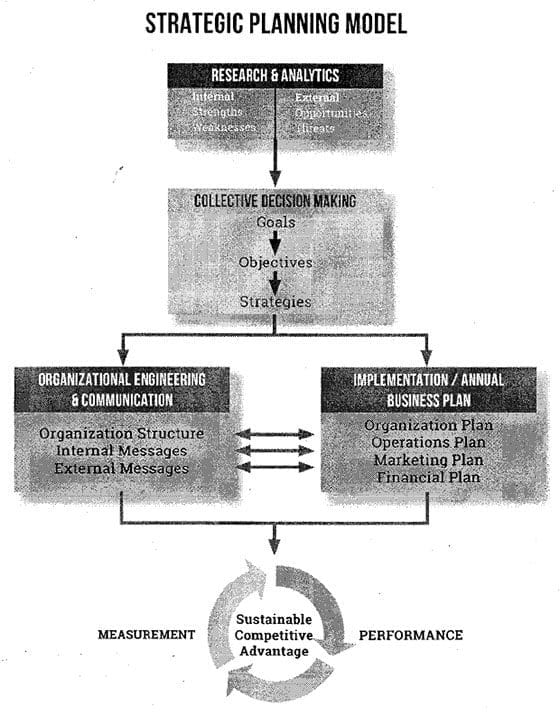Fall is a Good Time for 2026 Planning Is it time to build your next…

SMPS – CPSM Exam – Industrial Marketing Planning
Industrial Marketing Planning is Based on Research.
What markets are growing, what markets are shrinking? What people assets do you have to move into different markets? That’s the research part of the industrial marketing planning. Once you have the research, you need to go after the market.
Marketing planning will match your employee’s talents to the emerging markets you have identified. Client and business development will manage the budding client relationships. Proposals will get you the work. Promotional activity will help your first successful project in the new industry be known. Professional management will put into place the tools needed to rinse and repeat.
Industrial Marketing Strategy Case Study Activity
This Case Study Activity allows you to reflect on and apply the key concepts that you learned in this Domain to a real-world scenario. Each Domain includes a scenario about the same organization, Gilmore & Associates. The scenario is presented to you, followed by several questions. You can also elect to view the recommended solutions/ responses for each question posed, which are located on the next page. This case study can be studied in many ways:
- You can individually reflect on the questions after reading the scenario, and write your own notes/responses to each question. You can then check your ability to apply the key concepts against the recommended solutions/responses.
- You can pull together a small group and use this scenario to drive a discussion around the challenge and to discuss solutions as a group.
- You can combine a selection of the case study activities (across the Domains) into a larger scenario-based activity as a part of a professional development event.
Your mid-sized engineering firm, Gilmore & Associates, has long been a leader in the construction of K-12 school facilities. Recent changes, driven by aging Baby Boomers and an influx of retirees, have caused this market to decline, and your CEO is looking to expand into the healthcare industry. As the marketing coordinator, you’ve made an assessment of you firm’s current situation and it’s clear that things need to change, as well over half of your current revenue is coming from school construction.
However, your preliminary research has identified several exciting new possibilities, including the need for upscale retirement homes and hospice facilities. Your CEO has tasked your group to come up with a marketing plan that will set the firm up to succeed in this new environment.
- Based on the demographic data, you’ve established that there’s a growing need for healthcare facilities in your area. You’re also clear that the strengths of your firm align better with building retirement homes rather than hospitals or clinics. What type of research would best help you in creating a plan that will turn these insights into a workable marketing plan?
- Besides conducting research, what are some of the key steps that you will take to develop your marketing plan?
- What things will you need to keep in mind when developing your marketing budget?
- What are some of the strategies that you will put into place to reach your marketing goals, as set forth in the plan?
- What measures will you put into place to assess how well your plan is performing?
Answer Key
- Based on the demographic data, you’ve established that there’s a growing need for healthcare facilities in your area. You’re also clear that the strengths of your firm align better with building retirement homes rather than hospitals or clinics. What type of research would best help you in creating a plan that will turn these insights into a workable marketing plan?Since you’re already clear on the demographic trends in your area, research how large the retirement home market will be for your area over the next five years (for example).You will need to decide whether to do your own research, perhaps by conducting surveys in carefully selected communities, or rely on secondary research by looking at existing industry data and local government research. The decision will come down to a question of cost and how much good data already exists. You will probably need to gather both qualitative and quantitative data-qualitative, in the sense that good retirement home design is something of an art; and quantitative, in that you will need to have hard numbers to back up any projections that you make about the number of facilities that will be needed.
- Besides conducting research, what are some of the key steps that you will take to develop your marketing plan?Identify the marketing forces that affect your business. For example, you can use Porter’s Five Forces model to assess your relative bargaining strength with potential clients, your relationship with suppliers, and how you measure up to the competition.Participate in strategic planning with senior staff to clarify the overall goals and objectives of the organization, to provide a context for the marketing plan that you are developing.Develop a vision statement that encapsulates the firm’s strategic objectives, and reflects how you want the company to be perceived in the marketplace. Just as you have been seen as the premier provider of school facilities in the region, your new goal is to become known as the Cadillac of the retirement home industry.Develop clear and quantifiable goals; for example, you could decide that your goal is to partner with a healthcare provider to build two profitable retirement facilities over the next two years.
Identify specific target markets. Where are you going to locate your retirement facilities? You may want them close to an existing hospital, for example, and within an easy bus ride to a cultural center.
- What things will you need to keep in mind when developing your marketing budget?You’ll need to decide on a budgeting methodology. Will you use the Projection Method, which looks at prior year costs to develop the upcoming year’s budget? Or the Percentage Method, which allocates a set percentage of the firm’s total operation revenues to marketing? Or will you go with GoalBased Budgeting, which assigns costs to each item in your marketing plan?You’ll have to budget for labor costs, by estimating the time that everyone in the firm will devote to marketing. This includes not only marketing staff, but the time spent by principals in marketing and selling.You’ll need to decide how to track expenses related to marketing, such as travel and entertainment, photography, printing costs, organization dues, office supplies, and the like.
- What are some of the strategies that you will put into place to reach your marketing goals, as set forth in the plan? Networking. You may find that firms that you have partnered with in the past are also looking to get into a new line of business. Contacting professional organizations in the healthcare industry, to better understand the specific issues surrounding elder-care facilities and to get to know key players in the healthcare community.Developing a public relations campaign to get the message out that you are becoming a player in the healthcare industry.
Building a presence on social media, both to advertise the new face of your company and to target prospective clients.
A good website. Any great industrial marketing plan requires a good, easy to navigate, informative website. - What measures will you put into place to assess how well your plan is performing?
You may want to use a CRM system to track leads, proposals, and the activities that drive costs and revenues, even if you track actual expenses in an accounting system. Lead reports, hit rate reports, and sales reports all provide quantifiable data on how well the company is doing month to month, and will provide an early warning if the plan is going off track. Benchmarking allows you to keep tabs on internal progress; by evaluating progress against an internal goal of generating X number of proposals in an quarter, for example, the marketing team can judge whether it is on track to fulfilling its overall goal of hitting its revenue goals.A cost/benefit analysis of your marketing effort will let you know the value that you are getting for the money and time expended. The key is to understand the total costs in time and money, and to fully appreciate the value realized.
Domain 2: Marketing Planning
Analyze Data of Relevant Industries and Competitors
- 1 Understand Methods and Models of Research
1.1.1 Action-Driving vs Action-Confirming Research
1.1.2 Primary vs Secondary Research
1.1.3 Qualitative vs Quantitative Research
1.2 Identify Sources of Relevant Data
1.3 Prioritize Data for Relevance to Firm’s Strategic, Marketing, and Business Development (BD) Plans
1.4 Reporting and Tracking of Data
1.5 Key Terms - Analyze Relevant Historical and Contemporary Data
2.1 Identify Sources of Relevant Data, Company’s Historic Data (Internal and External)
2.2 Models for Identifying Market Forces
2.2.1 Porter’s Five Forces
This really focuses on the power of the people that control the industry. They will not want you to take their cheese. Buyers will do what they have always done and may want a bribe. Suppliers won’t help you learn their other customers. In common technologies, competitors are everywhere. I’m not quite sure what, “The best market is the one that is difficult to enter, yet easy to exit.” If that was the case, I should leverage my Frank Lloyd Wright House. It is what has gotten me into researching the architectural, engineering and construction markets but they have not been easy to enter. But learning this SMPS methodology will help me enter the market. TO wrap up Porter’s Five Forces substitute products can’t be invented that fast in marketing as long as you keep up with the internet. The final one is rivalry. There’s a lot of that.
2.2.2 EPISTLE
Economic
Political
International
Socio-Cultural
Technological
Legal
Environmental
All of these things can prevent your success. They are why it is so frustrating to enter a new market or invent one.
2.3 Key Terms - Analyze Focused Market-Specific Data
3.1 Describe and Analyze Data
3.2 Forecast Based on Collected Information
3.3 Key Terms - Interpret Market Research Results
You always have to reconfirm your research.
4.1 Analysis vs Interpretation of Data
4.2 Forecast Based on Collected Information
4.3 Key Terms - Conduct a Strengths, Weaknesses, Opportunities, and Threats (SWOT) Analysis
5.1 Understand How to Construct a SWOT Matrix
5.2 Tactics for Identifying Strengths, Weaknesses, Opportunities, and Threats
5.3 Setting Priorities for a SWOT Analysis
Every marketing activity needs to start with thinking about your Strength and Weaknesses and your outside Opportunities and Threats.
5.4 Alternative Models
5.5 Key Terms - Collect Industry Marketing Cost Data
6.1 Identify Sources of Relevant Data
6.2 Analyze and Apply Data
6.3 Key Terms - Participate in Strategic Planning
This is always the easiest thing to say you are going to do but almost impossible to execute. This marketing methodology will help you succeed. I used to think they were a meaningless example of corporate bullshit. But when properly used a strategic plan really is a survival plan. You need to be a driven company whose goal is to enter new markets. Most strategic plans are just marketing mush, a real plan is a real need when it comes to successful industrial marketing strategy.

7.1 Understanding the Strategic Planning Process/Models
It’s all hidden in the illustration. The target, the reason, the willpower, the weapons and the victims, “(you) will be the first to find, and profitably capitalize on, emerging opportunities before the competition can.”
7.2 Understanding the Firm’s Big Picture Operations and Finance
7.3 Bringing Relevant Data to the Table
7.4 Key Terms - Develop a Vision Statement – What you aspire to be?
Here’s another one I just don’t get. No words on a piece of paper can change the future. It comes down to caring. What do you care about? That is the only reason things change. Making a statement about yourself doesn’t convince clients to work with you. Or your employees.
8.1 Understand Your Firm’s Brand Promise and Core Values
8.1.1 What’s Our Vision for the Firm?
8.1.2 What’s Our Mission? Where do you want to go?
8.1.3 What Do We Want to be Known For?
8.1.4 What Do We Like to Do Most?
8.1.5 Who Are We Competing Against, and What Makes Us Different?
8.2 Analyze Your Firm’s Current Position in the Marketplace
8.3 Facilitate Discussion with Senior Leadership
8.4 Be Effective as Part of the Team (Team Dynamics, Collaboration)
8.5 Writing Skills
8.6 Key Terms - Develop Goals and Objectives
How are you going to get there?
9.1 Analyze Your Current Effort
9.2 Identify the Results (Sales, Positioning, etc.) You Want to Achieve, With a Time Frame for Achieving Them
Specific
Measurable
Attainable
Relevant
Time-Based
9.3 Identify How Your Goals and Objectives Relate to Your Vision Statement, and Measurable Results for Goal Achievement
9.4 Internal Benchmarking, and Developing/Tracking Progressive Goals
9.5 Establish Performance Metrics
9.6 Key Terms - Facilitate the Planning Process
10.1 The Basics of Facilitation
10.1.1 Wearing Different Hats
10.2 Understand the Firm’s Goals
10.3 Keep Group on Agenda and Moving Forward 10.3.1 Managing Conflict
10.4 Involve Everyone, Making Sure Contributions are Considered and Included
10.5 Make Sure That Participants Achieve a Mutual Understanding
10.6 Record and Identify Related Action Items
10.7 Understand Different Motivations and Personality Types
Myers-Brigg Type Indicator
Decisive
Interactive
Stabilizing
Cautious
10.8.Key Terms - Select Target Markets
11.1 Examine Current Markets and Financial Performance for Each Market (Internal)
11.2 Review Market Research (Trends, Cultural, etc.)
11.3 Prioritize Opportunities that Maximize Your Firm’s Unique Value Proposition·
11.4 Key Terms - Create a Marketing Plan
One year part of a 3-5 year strategic plan with specific training to be done and battles to be won.
12.1 The Components of a Marketing Plan
12.2 Facilitate the Planning Process to Support and Integrate with the Strategic, BD, and Action Plans
12.3 Key Terms - Create a Marketing Budget
13.1 Budgets Support Your Marketing Plan
13.2 Budgets Should Have a Structure that Relates to Your Firm Structure
13.3 Choosing an Appropriate Methodology for Budgeting
13.3.1 The Projection Method or Comparison – uses past expense to predict future costs
13.3.2 The Percentage Method – 3 to 18 %
13.3.3 The Goal-Based Budgeting Method or Bottom-Up Method – assigns a cost to each marketing activity
13.4 How to Budget for Labor Costs
13.4.1 Calculating Available Time
13.4.2 Budgeting for the Principals
13.5 How to Budget for Expenses
13.6 Key Terms - 14 Set Marketing Goals
14.1 Strategies for Achieving Your Goals
14.1.1 Past and Current Clients
14.1.2 Cold Calling
14.1.3 Networking
14.1.4 Professional Organizations
14.1.5 Community Activities
14.2 Communications Activities
14.2.1 Branding
14.2.2 Public Relations
14.2.3 Social Media
14.2.4 Speaking and Writing
14.3 Key Terms - Manage implementation of a Marketing Plan
15.1 Systems for Tracking Leads
15.1.1 Customer Relationship Management (CRM) Systems
15.1.2 Going the Extra Mile
15.2 Manage People Effectively/Understand Different Individual Motivations·
15.3 Key Terms - Manage the Marketing Budget
16.1 Systems Tools for Tracking
16.2 How to Manage Vendors/Consultants
16.3 Key Terms - Estimate the Impact of Marketing on the Bottom Line
17.1 Measuring Performance
17.2 Key Terms - Estimate Return on Investment of the Marketing Plan
18.1 Benchmark and Measure
18.1.1 Drivers vs Indicators
18.1.2 Understand How Your Firm Defines Success
18.2 Financial Basics
18.3 Systems for Tracking
18.3.1 The Marketing Budget and ROI
18.3.2 Tracking Your Overall Marketing Effort by Tactic
18.4 Key Terms - Conduct a Cost/Benefit Analysis of Marketing Efforts
19.1 Understand the Total Costs (Time and Money)
19.2 Value-Based Decision Making
19.2.1 Quantitative Value
19.2.2 Qualitative Value
19.3 Basic Accounting Principles
19.4 Key Terms - Provide a Progress Report on the Marketing Plan
20.1 Regularly Review Performance Metrics Related to Goals
20.2 Intervals
20.3 Presentation Techniques (Also Applies to Reporting Techniques)
20.4 Key Terms - Revise the Marketing Plan
21.1 Update and Review Market Research for Changes in Market Situation
21.2 Adjust Marketing Plan to Reflect New Information
21.3 The 12-Month Rolling Budget
21.4 Key Terms




